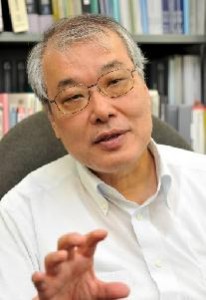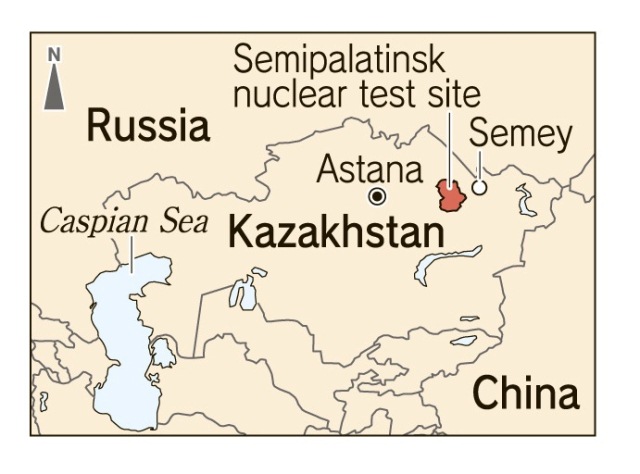Expert in radiation from Hiroshima to serve as visiting professor and conduct research on radiation exposure in Kazakhstan
Oct. 24, 2013
Masaharu Hoshi, 65, a professor emeritus at Hiroshima University and a specialist in radiation biology and physics, has assumed the post of visiting professor at Semey State Medical University, located in Semey (formerly Semipalatinsk), Kazakhstan. Dr. Hoshi has studied the impact of radiation on local residents and the Kazakh soil for about 20 years. His achievements in the country, which suffered years of nuclear testing during the former Soviet era, have led to this appointment.
Dr. Hoshi will be provided with a laboratory for his work and will live in Kazakhstan over four months a year. In addition to giving lectures to medical students, he will continue his efforts to clarify the actual conditions of the radiation contamination wrought by the nuclear tests and study the effects of radiation exposure on the human body.
Dr. Hoshi plans to study the extent of radiation exposure on bricks, soil, and teeth in a joint research project with “Semey State University named after Shakarim,” a university of science and technology, as well as the Kazakh Scientific Research Institute for Radiation Medicine and Ecology. Dr. Hoshi has accumulated know-how on the impact of radiation to date and the additional data from his new research will promote further analysis. His appointment is also expected to contribute to developing human resources in this field.
Dr. Hoshi’s new position was confirmed this past summer by Tolebay K. Rakhypbekov, the president of Semey State Medical University, when Dr. Hoshi was visiting Kazakhstan in August and September. Dr. Hoshi said, “I would like to study the doses of radiation exposure received in the many villages around the nuclear test site, with an eye on the effects of internal exposure.”
In 2012, Dr. Hoshi, along with other doctors from Hiroshima, was invited to the medical school in Kazakhstan to give a series of intensive lectures there. The first such series consisted of three experts delivering a total of 12 90-minute lectures over four days. These lectures were on various themes, including basic knowledge of radiation; diseases involving the thyroid gland, suffered by many who were exposed to the nuclear tests; and medical treatment for cancer of the large intestine and breast cancer.
Keywords
Radiation sufferers in Kazakhstan
The Semipalatinsk nuclear test site, located in Kazakhstan, was the largest nuclear test site administered by the former Soviet Union. Between 1949 and 1989, over 450 nuclear tests were conducted. Of these, more than 100 tests were performed in the air or on the ground, spreading radioactive substances over wide areas. This exposure has resulted in serious harm to the health of residents who lived in the vicinity of the test site, including various forms of cancer and abnormal births. Even today, many people still continue to suffer from cancers and heart ailments. It is estimated that as many as 1.5 million people have been affected by the nuclear tests.
(Originally published on October 21, 2013)
Dr. Hoshi will be provided with a laboratory for his work and will live in Kazakhstan over four months a year. In addition to giving lectures to medical students, he will continue his efforts to clarify the actual conditions of the radiation contamination wrought by the nuclear tests and study the effects of radiation exposure on the human body.
Dr. Hoshi plans to study the extent of radiation exposure on bricks, soil, and teeth in a joint research project with “Semey State University named after Shakarim,” a university of science and technology, as well as the Kazakh Scientific Research Institute for Radiation Medicine and Ecology. Dr. Hoshi has accumulated know-how on the impact of radiation to date and the additional data from his new research will promote further analysis. His appointment is also expected to contribute to developing human resources in this field.
Dr. Hoshi’s new position was confirmed this past summer by Tolebay K. Rakhypbekov, the president of Semey State Medical University, when Dr. Hoshi was visiting Kazakhstan in August and September. Dr. Hoshi said, “I would like to study the doses of radiation exposure received in the many villages around the nuclear test site, with an eye on the effects of internal exposure.”
In 2012, Dr. Hoshi, along with other doctors from Hiroshima, was invited to the medical school in Kazakhstan to give a series of intensive lectures there. The first such series consisted of three experts delivering a total of 12 90-minute lectures over four days. These lectures were on various themes, including basic knowledge of radiation; diseases involving the thyroid gland, suffered by many who were exposed to the nuclear tests; and medical treatment for cancer of the large intestine and breast cancer.
Keywords
Radiation sufferers in Kazakhstan
The Semipalatinsk nuclear test site, located in Kazakhstan, was the largest nuclear test site administered by the former Soviet Union. Between 1949 and 1989, over 450 nuclear tests were conducted. Of these, more than 100 tests were performed in the air or on the ground, spreading radioactive substances over wide areas. This exposure has resulted in serious harm to the health of residents who lived in the vicinity of the test site, including various forms of cancer and abnormal births. Even today, many people still continue to suffer from cancers and heart ailments. It is estimated that as many as 1.5 million people have been affected by the nuclear tests.
(Originally published on October 21, 2013)









